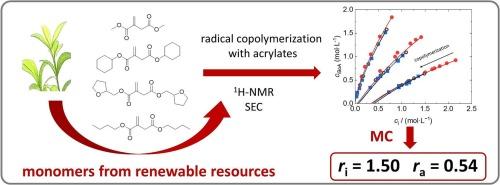Reactivity ratios of bio-based itaconates and acrylates in radical copolymerizations
IF 6.3
2区 化学
Q1 POLYMER SCIENCE
引用次数: 0
Abstract
Replacing petrochemically-based monomers by bio-based building blocks is an important topic in polymer chemistry. Recently, itaconic acid and its derivatives are investigated as potential alternatives. Free-radical polymerizations of these monomers are associated with a very low propagation rate. Moreover, the propagation reaction becomes reversible already at temperatures of 60 °C, which limits the accessible monomer conversion. To overcome these issues, copolymerizations with acrylates are attractive due to not being prone to depropagation at typical polymerization temperatures and fast propagation rates. Due to the presence of acrylate units in the copolymer higher monomer conversions are accessible compared to homopolymerizations. Since copolymer properties are strongly depending on the copolymer composition, their prediction via reactivity ratios (r values) is important. Here, r values determined via Monte Carlo simulations with consideration of depropagation are reported for several copolymerizations of three itaconates and four acrylates with non-functional ester groups. Polymer characterization is based on SEC elution curves and 1H NMR spectra recorded with an 80 MHz benchtop NMR spectrometer. A common pair of reactivity ratios is obtained, with 1.50 and 0.54 for the itaconate and acrylate comonomer, respectively. It is shown that these r values can be transferred to other non-functional comonomer pairs.

生物基itacon酸酯和丙烯酸酯在自由基共聚中的反应性比率
用生物基构件代替石油化工基单体是高分子化学中的一个重要课题。近年来,衣康酸及其衍生物作为潜在的替代品进行了研究。这些单体的自由基聚合具有非常低的繁殖速率。此外,在60℃的温度下,扩散反应已经可逆,这限制了单体转化的可及性。为了克服这些问题,丙烯酸酯的共聚是有吸引力的,因为在典型的聚合温度和快速的聚合速率下不容易脱聚。由于共聚物中丙烯酸酯单元的存在,与均聚反应相比,单体转化率更高。由于共聚物的性质很大程度上取决于共聚物的组成,因此通过反应性比(r值)来预测共聚物的性质是很重要的。在这里,通过蒙特卡罗模拟确定的r值考虑了退聚,报告了三种itacon酸酯和四种丙烯酸酯与非官能团的共聚。聚合物表征是基于SEC洗脱曲线和1H核磁共振谱记录与80 MHz台式核磁共振光谱仪。得到了一对共同的反应比,衣康酸酯和丙烯酸酯单体分别为1.50和0.54。结果表明,这些r值可以转移到其他非功能共聚单体对上。
本文章由计算机程序翻译,如有差异,请以英文原文为准。
求助全文
约1分钟内获得全文
求助全文
来源期刊

European Polymer Journal
化学-高分子科学
CiteScore
9.90
自引率
10.00%
发文量
691
审稿时长
23 days
期刊介绍:
European Polymer Journal is dedicated to publishing work on fundamental and applied polymer chemistry and macromolecular materials. The journal covers all aspects of polymer synthesis, including polymerization mechanisms and chemical functional transformations, with a focus on novel polymers and the relationships between molecular structure and polymer properties. In addition, we welcome submissions on bio-based or renewable polymers, stimuli-responsive systems and polymer bio-hybrids. European Polymer Journal also publishes research on the biomedical application of polymers, including drug delivery and regenerative medicine. The main scope is covered but not limited to the following core research areas:
Polymer synthesis and functionalization
• Novel synthetic routes for polymerization, functional modification, controlled/living polymerization and precision polymers.
Stimuli-responsive polymers
• Including shape memory and self-healing polymers.
Supramolecular polymers and self-assembly
• Molecular recognition and higher order polymer structures.
Renewable and sustainable polymers
• Bio-based, biodegradable and anti-microbial polymers and polymeric bio-nanocomposites.
Polymers at interfaces and surfaces
• Chemistry and engineering of surfaces with biological relevance, including patterning, antifouling polymers and polymers for membrane applications.
Biomedical applications and nanomedicine
• Polymers for regenerative medicine, drug delivery molecular release and gene therapy
The scope of European Polymer Journal no longer includes Polymer Physics.
 求助内容:
求助内容: 应助结果提醒方式:
应助结果提醒方式:


